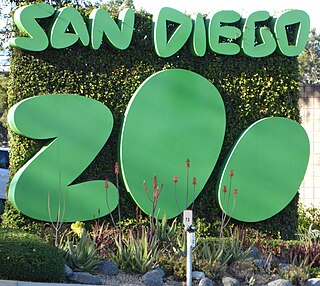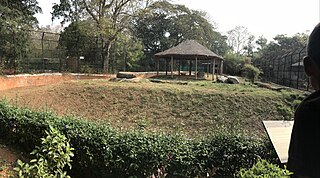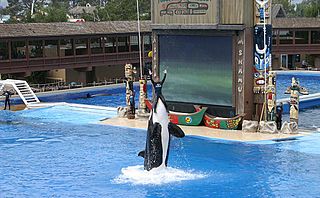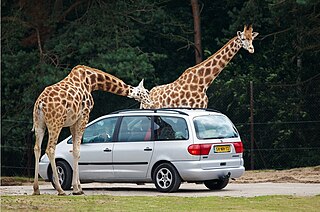 W
WA zoo is a facility in which animals are housed within enclosures, cared for, displayed to the public, and in some cases bred.
 W
WA bear pit was historically used to display bears, typically for entertainment and especially bear-baiting. The pit area was normally surrounded by a high fence, above which the spectators would look down on the bears.
 W
WBehavioral enrichment is an animal husbandry principle that seeks to enhance the quality of captive animal care by identifying and providing the environmental stimuli necessary for optimal psychological and physiological well-being. Environmental enrichment can either be active or passive, depending on whether it requires direct contact between the animal and the enrichment. A variety of enrichment techniques are used to create desired outcomes similar to an animal's individual and species' history. Each of the techniques used are intended to stimulate the animal's senses similarly to how they would be activated in the wild. Provided enrichment may be seen in the form of auditory, olfactory, habitat factors, food, research projects, training, and objects.
 W
WCaptive breeding, also known as "captive propagation", is the process of maintaining plants or animals in controlled environments, such as wildlife reserves, zoos, botanic gardens, and other conservation facilities. It is sometimes employed to help species that are being threatened by human activities such as habitat loss, fragmentation, over hunting or fishing, pollution, predation, disease, and parasitism. In some cases a captive breeding program can save a species from extinction, but for success, breeders must consider many factors—including genetic, ecological, behavioral, and ethical issues. Most successful attempts involve the cooperation and coordination of many institutions.
 W
WCaptive white tigers are of little known lineage. They are held captive around the world, usually for financial purposes. The Tiger Species Survival Plan devised by the Association of Zoos and Aquariums has condemned the breeding of white tigers. The genes responsible for white colour are represented by 0.001% of the tiger population. However, in 2008–2009, a closing stock of 264 Bengal tigers and 100 white Bengal tigers were accounted for in Indian zoos. The disproportionate growth in numbers of the latter points to the relentless inbreeding resorted to among homozygous recessive individuals for selectively multiplying the white animals. This progressively increasing process will eventually lead to inbreeding depression and loss of genetic variability.
 W
WAnimals that are held by humans and prevented from escaping are said to be in captivity. The term is usually applied to wild animals that are held in confinement, but may also be used generally to describe the keeping of domesticated animals such as livestock or pets. This may include, for example, animals in farms, private homes, zoos and laboratories. Animal captivity may be categorized according to the particular motives, objectives and conditions of the confinement.
 W
WThe prohibition "do not feed the animals" reflects a policy forbidding the artificial feeding of wildlife in situations where the animals, or the people doing the feeding, might be harmed. Signs displaying this message are commonly found in zoos, circuses, animal theme parks, aquariums, national parks, parks, public spaces, farms, and other places where people come into contact with wildlife. In some cases there are laws to enforce such no-feeding policies. However, some people openly and strongly oppose such laws claiming that animals such as pigeons can be an amenity for people who do not have company such as friends or family, and say that the laws prohibiting feeding animals in urban places must change. In some countries, such as Greece, feeding the pigeons in cities is a widespread practice. Cultural hostility to feeding animals in cities and laws that ban the practice raise concerns about how humans relate to other living beings in the urban environment. Politicians have also protested laws that ban feeding feral pigeons in cities. Feral pigeons in cities existed for thousands of years but only recently in some countries humans started seeing them as a nuisance and became hostile to them. In India, feeding feral animals in cities is considered a noble act. Academicians say that how humans treat animals is related to how humans treat each other and thus raise concerns about the cultural shift from seeing feral city pigeons as harmless in the 1800s to seeing them an undesirable in some countries in the 2000s.
 W
WA species that is extinct in the wild (EW) is one that has been categorized by the International Union for Conservation of Nature as known only by living members kept in captivity or as a naturalized population outside its historic range due to massive habitat loss.
 W
WA frozen zoo is a storage facility in which genetic materials taken from animals are stored at very low temperatures (−196 °C) in tanks of liquid nitrogen. Material preserved in this way can be stored indefinitely and used for artificial insemination, in vitro fertilisation, embryo transfer, and cloning. Some facilities also collect and cryopreserve plant material.
 W
WA herpetarium is a zoological exhibition space for reptiles and amphibians, most commonly a dedicated area of a larger zoo. A herpetarium which specializes in snakes is an ophidiarium or serpentarium, which are more common as stand-alone entities. Many serpentariums milk snakes for venom for medical and scientific research.
 W
WAn immersion exhibit is a naturalistic zoo environment that gives visitors the sense of being in the animals' habitats. Buildings and barriers are hidden. By recreating sights and other sensorial input from natural environments, immersion exhibits provide an indication about how animals live in the wild.
 W
WA marine mammal park is a commercial theme park or aquarium where marine mammals such as dolphins, beluga whales and sea lions are kept within water tanks and displayed to the public in special shows. A marine mammal park is more elaborate than a dolphinarium, because it also features other marine mammals and offers additional entertainment attractions. It is thus seen as a combination of a public aquarium and an amusement park. Marine mammal parks are different from marine parks, which include natural reserves and marine wildlife sanctuaries such as coral reefs, particularly in Australia.
 W
WA menagerie is a collection of captive animals, frequently exotic, kept for display; or the place where such a collection is kept, a precursor to the modern zoological garden.
 W
WA nocturnal house, sometimes called a nocturama, is a building in a zoo or research establishment where nocturnal animals are kept and viewable by the public. The unique feature of buildings of this type is that the lighting within is isolated from the outside and reversed; i.e. it is dark during the day and lit at night. This is to enable visitors and researchers to more conveniently study nocturnal animals during daylight hours.
 W
WOur Zoo is a British drama television series from BBC One, first broadcast on 3 September 2014. The six-part series, written by Matt Charman and directed by Andy De Emmony, is about George Mottershead, his dreams of creating a cage-free zoo, his family and how their lives changed when they embarked on the creation of Chester Zoo.
 W
WA petting zoo features a combination of domesticated animals and some wild species that are docile enough to touch and feed. In addition to independent petting zoos, also named children's farms or petting farms, many general zoos contain a petting zoo.
 W
WThe Insectarium is a museum about insects located in the Northeast part of Philadelphia, Pennsylvania. The museum opened in 1992 and features displays of many types of live insects, mounted specimens, exhibits and hands-on activities. Examples of the live insects include honeybees, tarantulas, cockroaches, scorpions, spiders, praying mantis, millipedes, beetles, water bugs, ants, and crickets. In 2017 the museum expanded and opened a 7,000-square-foot greenhouse for a year-round butterfly pavilion.
 W
WA safari park, sometimes known as a wildlife park, is a zoo-like commercial drive-in tourist attraction where visitors can drive their own vehicles or ride in vehicles provided by the facility to observe freely roaming animals.
 W
WThe Secret Life of the Zoo is a British documentary programme produced by Blast! Films on behalf of Channel 4. The series is filmed on location at Chester Zoo in the North West of England, and focuses on the behaviour of the animals at the zoo and their relationships with the keepers. The first five series were narrated by Olivia Colman. Actress Tamsin Greig took over narration from the sixth series.
 W
WThe American Species Survival Plan or SSP program was developed in 1981 by the (American) Association of Zoos and Aquariums to help ensure the survival of selected species in zoos and aquariums, most of which are threatened or endangered in the wild.
 W
WA virtual zoo is a new concept that uses the zoo model in a web format. Virtual zoos are basically websites that are created to simulate a visit to a zoo, and the visitors to these sites can view exhibits about animals and their habitats. Many Zoos as well as schools have developed virtual zoos. For example, instead of actual animals a virtual zoo will have articles and photos as exhibits. There are many virtual zoos that have been created; most are small and unremarkable, while some have hundreds of exhibits.